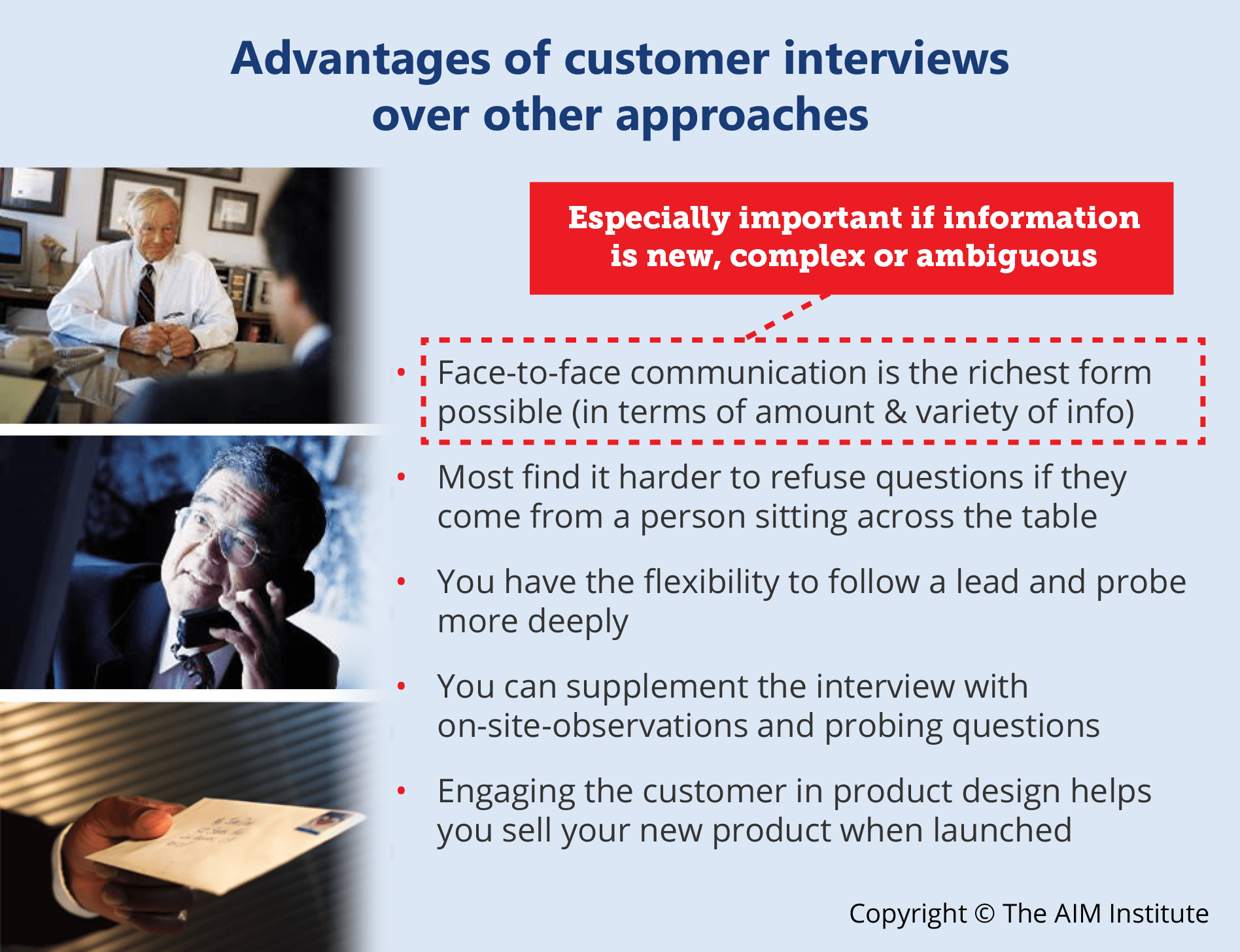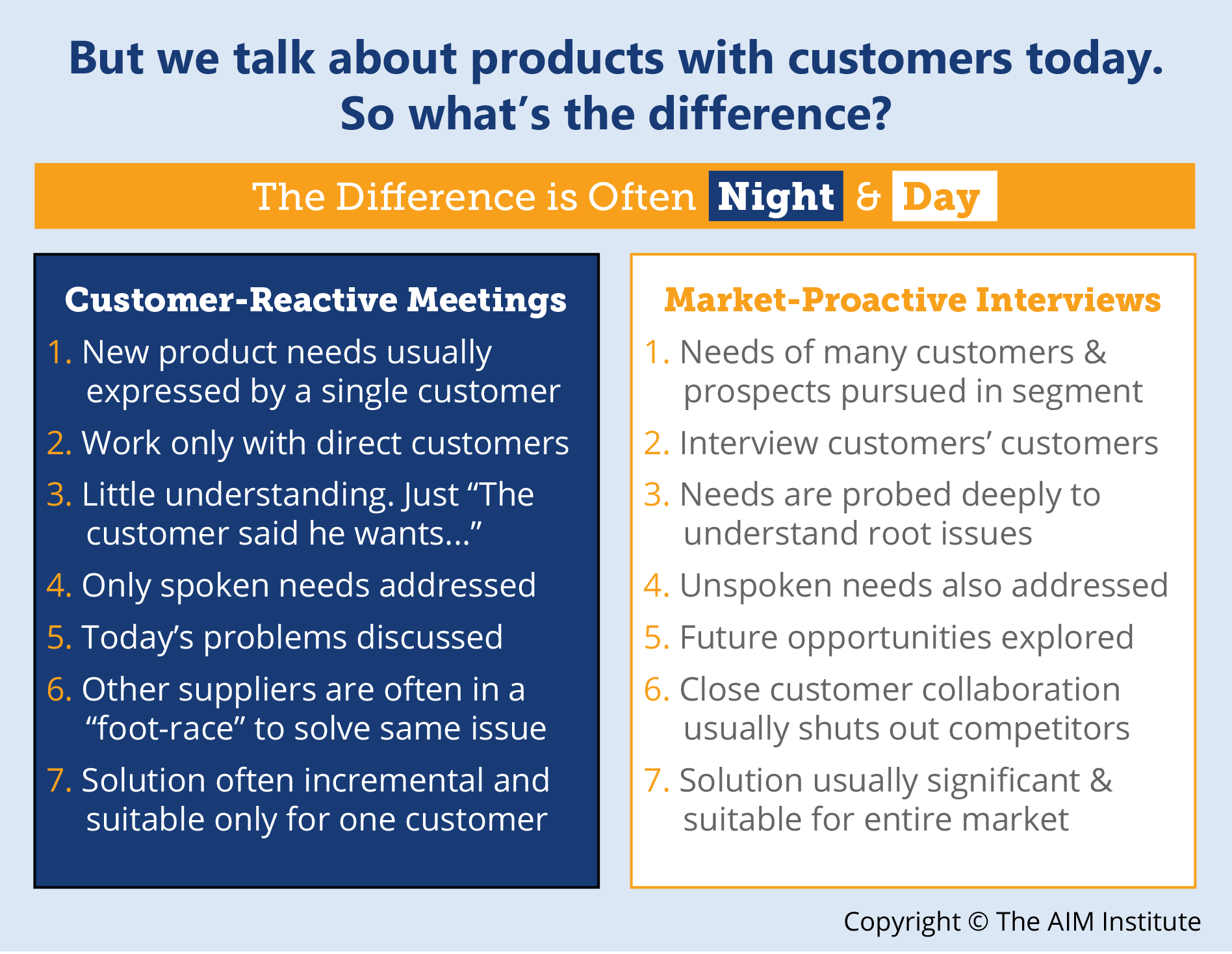Voice of Customer Interviews: It pays to excel

What if your company could pick just one competency to truly master? What would it be? Acquisitions? Perhaps, but if you buy businesses and then can’t grow them, you’ll just build a house of cards. How about operational efficiency or quality or service? These are important, but if others match you—and they usually do—you’re in a race to the bottom of a commoditization spiral. Did “voice of customer interviews” come to mind? If not… let’s consider where differentiation comes from.
Be Different to Differentiate
I find that most industrial leaders want profitable, sustainable top-line growth, and they look to new products for this. But not product “tweaks.” They want differentiated products customers will pay top dollar for and competitors can’t match anytime soon.
Now here’s the interesting part. Differentiated products must be… different. And yet, many producers behave the same as their competitors while hoping for different results. I don’t hear business leaders say, “Our R&D staff is 20% smarter than competitors’, so our products generally win.” And few plan to win by understanding customer needs better than competitors… which would let them “aim” their R&D brainpower better.
How can Voice of the Customer Tools help with interviews? Click here to learn more.
Nothing Comes Close to a Good Voice of Customer Interview
That brings us to the subject of this briefing: Voice of Customer interviews. Of all the ways to learn about customer needs—telephone, mail survey, internet—nothing comes close to face-to-face customer interviews. And if the information being sought is new, complex or ambiguous—as with industrial product design—the advantages of interviews become even greater.

So is the voice of customer interview a key fixture in most new product development processes? For too many producers, the answer is no. Perhaps with so much routine customer interaction taking place, it’s assumed some of it must be interviewing. But if you examine the call frequency and objectives of your sales and technical service staff, you will most likely find that over 95% of face-to-face customer communication is of the “tell-and-sell” variety.
What’s the real difference for B2B vs. B2C Interviews? Click here to learn more!
Some might protest, “But we get lots of input from our customers on what they want in new products.” As shown in the image below, the difference between that and what I’m proposing is the difference of night and day. Most new product discussions are actually customer-reactive meetings, not market-proactive interviews.

Voice of Customer Interviews: Market-Proactive Sessions
You’ll know one of these when you see it: First, a team targets an attractive market segment to pursue. Then it schedules interviews with customers, prospects and their customers’ customers. Two-person technical-marketing teams carefully prepare their questions and interviewing roles in advance.
During the voice of customer interviews, these teams use advanced listening, probing and interviewing skills to plumb incredible depths… and the customers love it! Someone explained it to me this way: “Dan, most people will never have someone listen this closely to them unless they pay ninety bucks an hour for a therapist.”
Of course, the big question is, “Does it work?” One clue is that product leaders such as 3M perennially train their people in these skills. Some of the earliest evidence came from Hewlett Packard’s customer visits nearly two decades ago. 90% of HP practitioners said their interviews directly impacted product offerings, and 76% reported these voice of customer interviews led to unexpected or surprising information.1
76% said their voice of customer interviews led to unexpected or surprising information
And that’s the point, isn’t it? If we just create products our customers ask everyone else for, and we haven’t cornered the market on R&D genius, we’re going to keep struggling with this differentiation. But if we intentionally and frequently expose ourselves to unexpected and surprising information–that our competitors lack–we can create much more significant and protectable value.
What Works… and What Doesn’t
I find most leaders earnestly want to launch a stream of exciting new products. After all, what else can so attract customers, please stockholders and put competitors on the defensive? But their tactics often fall short:
- They throw more money at R&D: Don’t skimp here, but a Soviet-style arms race can be inefficient and a poor gamble.
- They ask tough questions: Keep asking them… but if your new product teams are not asking these and many more questions before you do, be nervous.
- They exhort the troops: Fine, but don’t repeat quality mistakes of the 70’s. Deming railed against pep talks unsupported by employee training in new methods (e.g. statistics).Most employees need much more training, especially in practices for the aptly-named “fuzzy” front-end (predevelopment-stage). Many have been trained in a Stage Gate® process which provides good discipline2. But, gate review after gate review, isn’t something becoming painfully obvious? Many product teams simply do not know how to explore unmet customer needs very well. Imagine if teams were taught how to uncover customer needs, the practice was uniformly applied across your company and it was continually refined to the highest possible skill level. You’d be doing things differently and you’d have more differentiated products. You’d have profitable, sustainable top-line growth.
Learning More
Edward F. McQuarrie’s book, Customer Visits, provides solid background on voice of customer interviews. You might also pick up one of the many voice-of-the-customer (VOC) books available. A word of caution, though. VOC methods often fail to take advantage of significant benefits B2B producers have over consumer goods producers. (But that’s the subject of another briefing.)
We’ve only been able to touch lightly on the type of training needed. It’s about new interviewing skills, like active listening, deep probing and collaborative brainstorming. But it’s also about targeting the right market segment in the first place, performing rigorous competitive benchmarking and building a bullet-proof business case prior to development. Also, companies with the proper tools, such as Blueprinter® software, will perform voice of customer interviews at a higher level – with better engagement and greater quality of insights.
For more information and in-depth look at our in-house training, visit our In-house blended New Product Blueprinting and Voice of The Customer Training Workshops page.
1 Edward F. McQuarrie, Customer Visits, 1998
2 Stage-gate® is a registered trademark of the Product Development Institute
Comments